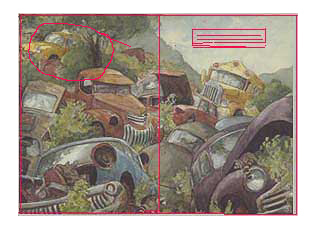Building a Story, One Spread at a Time
Here’s a little about making a dummy book, a set of folded pages that help the writer see how the story will grow. In a picture book there are pages, but the reader sees the story a spread at a time, on two facing pages. The idea is to construct something that shows what the spreads in finished book will look like as you turn the pages. In this dummy I just put the pictures and left blank spaces for words. I made mostly black and white pictures with a few sample full color illustrations to show a publisher the watercolor pictures I hope to make.

Here is the first spread — that’s 2 facing pages — in my dummy book. The picture is a pencil drawing copied on xerox machine, then pasted into a book of folded, stapled pages.
The story starts with Axel, the main character being dragged into the junkyard. Lots of people think of the junkyard as a bad place, but this junkyard looks like the junkyards I visited to get parts to keep old cars going. I like walking among the old cars rusting in the weeds. Sometimes you’ll strange things, like big trees growing up through the hood of a car, trees that are twenty or thirty years old.
You can see that I set up the first spread to look like it was a sad thing to be dragged into a junkyard, but you’ll see that arriving in the junkyard is really the beginning of a new life for Axel.
Below is a full color watercolor painting, this is what the reader will see when they turn the page of the story, right after after reading about the squirrels getting into Axel’s trunk. This picture is the readers first view of the junkyard.

In this watercolor of the junkyard you see lots of old cars and a school bus too. The main character Axel is in the upper left corner of the picture — that yellow taxi under a tree. In the picture below he’s circled in red. I my painting I tried to show how fine it is in the junkyard, so full of life and history — a nice place to rust with lots of time to hang out and watch the day go by. And of course the cars tell stories too.
Here I’ve shown how this picture will work in the book. This illustration will go in the book as a full spread — you can see the red line down the middle is where the fold will be. That’s called the gutter and nothing important goes there. The red box shows where I will put the words.

“No more rushing around guzzling gas, or idling bumper to bumper in city traffic with his meter ticking endlessly.”
“Axel sat comfortably rusting after a gentle rain and let some air hiss out of his tires. Country life was so restful he was thinking about letting his back doors fall off when a cold polished voice said, ‘Even in the junkyard one needn’t be a wreck.’?
